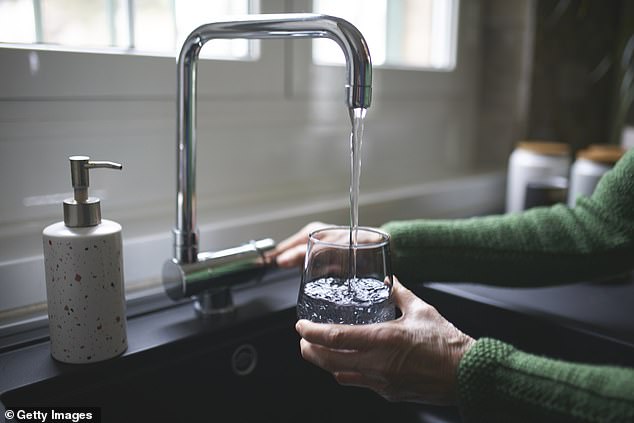Alarming research shows that 100 million Americans live in areas with cancer-causing ‘forever chemicals’ in their water
Nearly 100 million Americans live in areas where the water supply is contaminated with toxic PFAS ‘forever chemicals,’ a government study warns.
For the first time, the US Geological Survey has estimated how many private water wells and utilities in small towns are full of chemicals linked to cancer and infertility.
In total, they estimate that 71 to 95 million people depend on water that contains chemicals in perpetuity. The states with the most citizens likely to be affected are Florida, California and Michigan.
PFAS chemicals are used to manufacture a number of products – from stain-resistant clothing to plastics and pesticides. In this map created by the USGS researchers, each dot represents a potential source of PFAS, according to their assessment. The different colors correspond to the different sources of PFAS
Forever chemicals — so named because they do not break down in our bodies or in our environment — have been used in manufacturing since the 1940s to make everything from nonstick cookware to firefighting foam to stain-resistant clothing.
These chemicals can leach into the soil through wastewater, chemical spills, or landfill buildup.
According to the EPA, long-term exposure to PFAS can lead to an increased risk of prostate, kidney and testicular cancer, developmental delays in children, reduced fertility in women and disruption of the body’s hormone balance.
The chemicals have also been shown to weaken the immune system, making it harder for your body to fight back against infections.
The Environmental Protection Agency created a law in 2024 requiring public drinking water systems to begin testing and restricting their water for PFAS by 2025.
However, the EPA rule does not apply to public utilities that serve fewer than 3,300 people.
Approximately 13 percent of the U.S. population lives in these zones, leaving an estimated 44 million people unaware of their exposure to PFAS.
The study authors said: ‘People in the United States may unknowingly drink water containing PFAS due to a lack of systematic analysis, especially in domestic water supplies.’
The new study looked at these water systems for the first time, estimating the number of people who could be exposed to PFAS in these areas, and published their findings in the magazine Science.
To do this, they created a model for public water supplies serving fewer than 3,300 people and household well users.
From 2019 to 2022, they collected well samples from three well networks in the US.
This gave them an idea of the amount of PFAS in groundwater around local airports, metal coating facilities, plastics manufacturers, fire training areas, chemical plants and national defense sites.
They analyzed the samples for 24 different types of PFAS chemicals.
Researchers then fed the data they collected into a complex machine learning algorithm, which projected their findings onto groundwater sources across the contiguous US.
This combined information on rural and private drinking water systems with the groundwater systems that supply larger public utilities before it is treated to remove chemicals.
In doing so, they discovered that the drinking water on which 71 to 95 million people depend may contain detectable levels of PFAS. The majority of this came from small public water systems.

EPA rules require public utilities in developed areas to test for PFAS in water supplies and limit chemicals — but that still leaves Americans in less populated areas and those who use private wells potentially exposed to chemicals forever, according to the scientists.
They found that the states with the largest number of potentially affected people were Michigan and Florida. The states with the largest percentage of people affected were Massachusetts and Washington DC
Nationwide, the area with the highest concentration of PFAS chemicals was found in the Biscayne Principal Aquifer in southern Florida.
The researchers said they hope their model can help people at high risk of exposure become more aware of their risk and push for testing.
They said: ‘The results are available for public consumption, allowing homeowners to evaluate the results in their area and determine if at-home testing or treatment are options they would like to pursue.’
If a water supplier knows that there are chemicals in their system at all times, they can treat them to limit the amount of chemicals that end up in your tap.
At home or from private sources, there are filters you can purchase to rid your water of these chemicals, but experts recommend only purchasing filters that are independently certified to filter PFAS.
Consumer Reports recommends looking for filters with stamps from the National Sanitation Foundation, Water Quality Association or International Association of Plumbing & Mechanical Officials.
These range from $45 to as much as $1,200, depending on whether you’re looking for a countertop, under-sink, faucet, or pitcher filter. Some brands they highlight are Brondell, Aquasana and Culligan.
